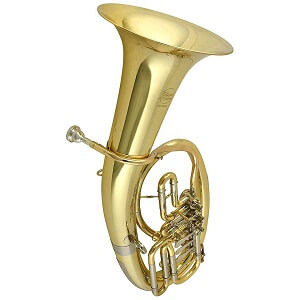Tenor Horn
 Through the history of music, several instruments are located in a median position, between the instruments dedicated to the main melody and those intended for the low register. Within the wind orchestras, an instrument has found its place in the fanfare bands and in British-style brass bands, under various names: alto saxhorn, alto or tenor flugelhorn, tenor horn, Althorn, E-flat horn, etc.
Through the history of music, several instruments are located in a median position, between the instruments dedicated to the main melody and those intended for the low register. Within the wind orchestras, an instrument has found its place in the fanfare bands and in British-style brass bands, under various names: alto saxhorn, alto or tenor flugelhorn, tenor horn, Althorn, E-flat horn, etc.
This instrument comes directly from the improvements made by Adolphe Sax, in the 1840s, to brass instruments. The Belgian maker, who emigrated to Paris, tried to modernize French military music. He perfected the large family of flugelhorns, valve instruments played with a mouthpiece, with a rather conical and wide bore, which will soon be called "saxhorns". First, he improved the valves in a patent he took out in 1843. Two years later, he took out a new patent for the "saxotromba", which is both a family of instruments and a well-defined form. This saxotromba shape, which is characterized by a vertical bell and valves parallel to the bell, could be applied to existing instruments such as cornets, trombones, horns, saxhorns. The specific form of the bell, directed upwards, was practical for musicians of cavalry regiments who could easily handle their instrument on horseback. In fact, it seems that the middle register instruments, called tenor or alto by Sax, were saxotrombas and not saxhorns, the latter theoretically having a larger bore. However, the term "saxhorn" finally prevailed for all sizes, before fading in favor of other names (alto, euphonium, bombardon, bass, etc.).
The alto or tenor saxhorn/saxotromba in E flat, more commonly known as "tenor horn" in English, was first manufactured exclusively by Adolphe Sax. But the demand was such that he allowed some other makers to make it under license. Once in the public domain, after 1865, its design was widely adopted in many countries. In Belgium, Van Engelen and Mahillon were among the first makers to adopt Sax's ideas.